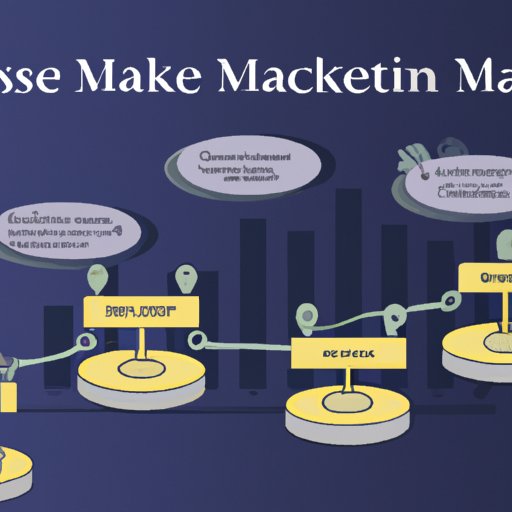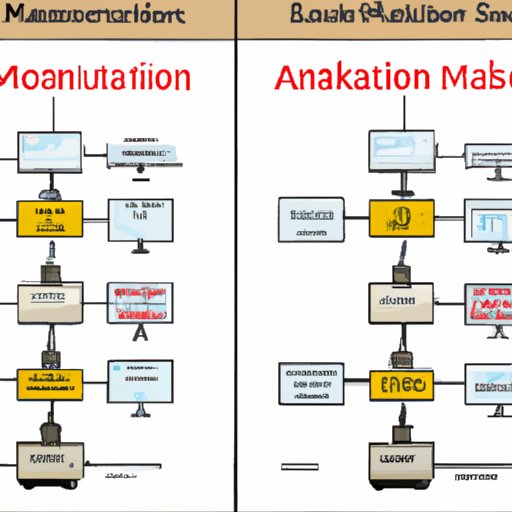Introduction
Market automation is a technology-driven process that automates manual tasks in marketing and sales operations. It helps businesses streamline their processes, improve efficiency, and reduce costs. This article will explore the basics of market automation, the benefits it offers, and the challenges and risks associated with it.
Exploring the Basics of Market Automation
What is market automation? Market automation is the use of technology to automate manual tasks in marketing and sales operations. This automation can include tasks such as creating customer databases, segmenting customers, tracking customer interactions, sending emails, creating campaigns, and more. By automating these tasks, businesses can save time and money, increase efficiency, and improve customer service.
There are several types of market automation solutions available, including software-as-a-service (SaaS) tools, cloud-based services, and custom-built solutions. Each type of solution has its own set of features, so it’s important to assess your needs before selecting a solution. In general, market automation solutions offer features such as customer segmentation, analytics, campaign management, email marketing, lead scoring, and automation rules.
How does market automation work? Market automation solutions are designed to automate everyday tasks, such as creating customer databases, segmenting customers, tracking customer interactions, sending emails, creating campaigns, and more. The automation process begins when data is collected from sources such as website visits, customer surveys, or customer feedback. This data is then used to create customer profiles and segment customers based on their interests and preferences. Once customers are segmented, automated messages can be sent to them, such as emails, text messages, or push notifications. Market automation solutions also provide analytics and reporting features, which allow businesses to track the effectiveness of their campaigns and make changes as needed.

How Market Automation Can Help Improve Your Business
Market automation can help businesses save time and money, increase efficiency, and improve customer service. It can also help businesses reach more customers, generate more leads, and increase sales.
Improved Efficiency: Automating mundane tasks such as customer segmentation and campaign management can free up time for employees to focus on more important tasks. Market automation solutions also provide analytics and reporting features, which allow businesses to quickly identify areas of improvement and take action accordingly.
Increased Productivity: Automating tasks can help businesses increase productivity by eliminating manual processes and reducing the amount of time spent on repetitive tasks. Automation also reduces errors, which can lead to improved accuracy and better results.
Cost Savings: Automating tasks can help businesses save money by reducing labor costs and increasing efficiency. Automation also eliminates the need for manual data entry, which can save businesses money on personnel costs.
Enhanced Customer Service: Automating customer service tasks such as responding to customer inquiries and providing personalized recommendations can help businesses deliver better customer experiences. Automated messages can also help businesses stay in touch with customers, build relationships, and encourage loyalty.
Benefits of Market Automation
Market automation offers numerous benefits for businesses, including:
Streamlined Processes: Automating tasks can help businesses streamline their processes by eliminating manual steps and reducing the amount of time spent on repetitive tasks. Automation also helps businesses standardize their processes, which can lead to improved efficiency and better results.
Data Analysis: Market automation solutions provide analytics and reporting features, which allow businesses to track the effectiveness of their campaigns and make changes as needed. This data can also be used to identify new opportunities and target specific customers.
Automated Reporting: Market automation solutions provide detailed reports on customer behavior and campaign performance. These reports can help businesses track progress, identify areas of improvement, and adjust their strategies accordingly.
Scalability: Automating tasks can help businesses scale their operations quickly and easily. Automation also eliminates the need for manual data entry, which can save businesses money on personnel costs.

Case Studies: Success Stories of Market Automation
The following case studies highlight how market automation has helped businesses succeed:
Company A: Company A implemented a market automation solution to automate mundane tasks such as customer segmentation and campaign management. This automation helped the company save time and money, while also increasing productivity and improving customer service. The automation also allowed the company to quickly identify new opportunities and target specific customers.
Company B: Company B implemented a market automation solution to automate customer service tasks. This automation helped the company save money on personnel costs and reduce errors. It also allowed the company to quickly respond to customer inquiries and provide personalized recommendations, resulting in improved customer satisfaction.
Company C: Company C implemented a market automation solution to automate repetitive tasks and streamline its processes. This automation helped the company save time and money, while also increasing efficiency and improving customer service. It also allowed the company to quickly identify areas of improvement and take action accordingly.
Challenges and Risks of Market Automation
Despite the many benefits of market automation, there are also some challenges and risks associated with it. These include:
Security Concerns: Automating tasks can introduce security risks, as sensitive customer data may be stored in an automated system. It’s important to select an automation solution with strong security measures in place to protect customer data.
Difficulty Implementing: Implementing a market automation solution can be difficult and time-consuming. It’s important to select a solution that is easy to implement and use, and provides adequate training and support.
Cost of Automation: Automating tasks can be expensive, as it requires an initial investment in automation software and hardware. It’s important to select a solution that fits within your budget and provides a good return on investment.
Step-by-Step Guide to Implementing Market Automation
Implementing market automation can be a complex process. Here are some steps to help you get started:
Assess Your Needs: Before selecting a market automation solution, it’s important to assess your needs and determine what type of solution is best suited for your business. This will help you narrow down your options and select a solution that meets your requirements.
Select an Automation Solution: Once you have assessed your needs, it’s time to select an automation solution. There are several types of market automation solutions available, so it’s important to compare features and prices before making a decision.
Develop Strategies: Once you have selected a market automation solution, it’s important to develop strategies for using the solution. This includes identifying goals, setting up campaigns, and developing processes for monitoring performance.
Train Employees: It’s important to train employees on how to use the solution and ensure they understand the processes and procedures. This will help ensure that everyone is on the same page and can effectively utilize the solution.
Monitor Performance: Once the solution is implemented, it’s important to monitor performance and make adjustments as needed. This will help ensure that you are getting the most out of the solution and achieving the desired results.

Comparison of Different Market Automation Solutions
When selecting a market automation solution, it’s important to compare features, prices, and user reviews. Here are some factors to consider when comparing different solutions:
Feature Comparison: It’s important to compare features to ensure that you are selecting a solution that meets your needs. Some features to look for include customer segmentation, analytics, campaign management, email marketing, lead scoring, and automation rules.
Price Comparison: It’s important to compare prices to ensure that you are selecting a solution that fits within your budget. Some solutions offer pay-as-you-go plans, while others offer monthly or annual subscriptions.
User Reviews: It’s important to read user reviews to get an understanding of how other users feel about the solution. This can help you determine if the solution is right for your business.
Conclusion
In conclusion, market automation can help businesses save time and money, increase efficiency, and improve customer service. It can also help businesses reach more customers, generate more leads, and increase sales. However, there are some challenges and risks associated with market automation, such as security concerns and difficulty implementing. It’s important to assess your needs, select an appropriate solution, and develop strategies before implementing market automation. By following these steps, businesses can reap the benefits of market automation and achieve their desired results.
(Note: Is this article not meeting your expectations? Do you have knowledge or insights to share? Unlock new opportunities and expand your reach by joining our authors team. Click Registration to join us and share your expertise with our readers.)
